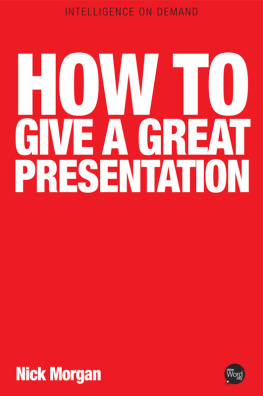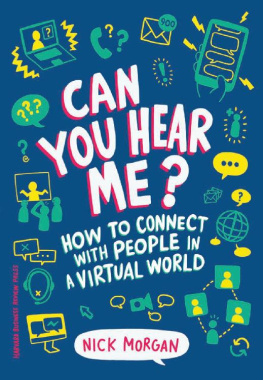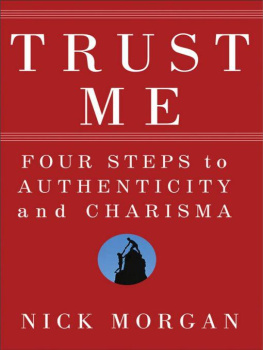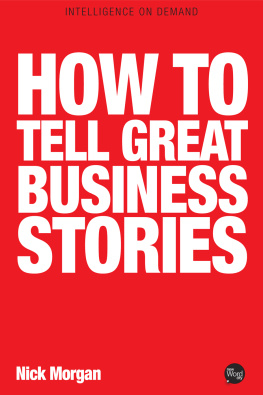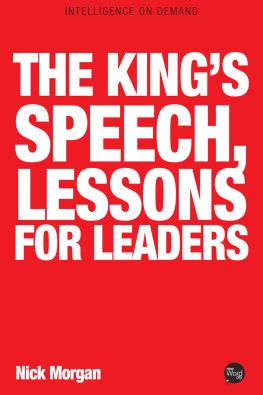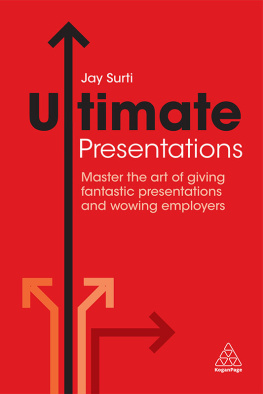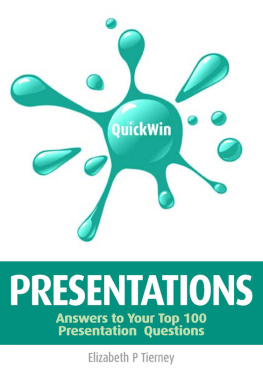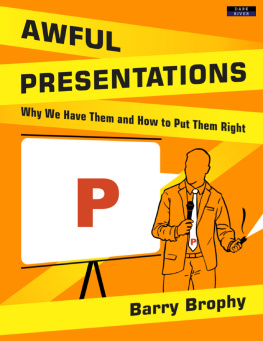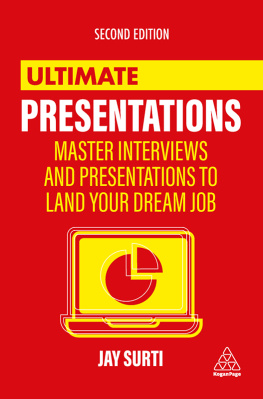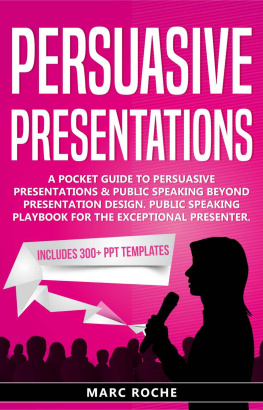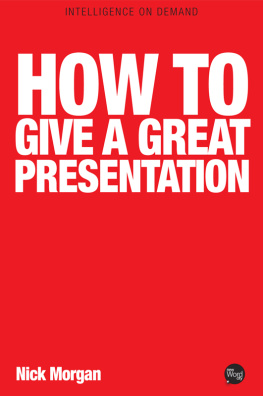So you have to give a presentation tomorrow. Your boss will be there, and a lot of other important people, and the pressures on to do a great job. Youve been asked to report on the state of the project youve been working on since forever. The idea is to bring everyone up to speed at least, thats what your boss said. You have no idea what she means are you supposed to tell the truth or make it look better than that? But its too late to ask for clarification. Its just you and PowerPoint, and youve got to produce.
Heres a simple 5-step process to get you ready in time and to cover you with glory or at least not get you fired.
Step 1. Figure out your point of view.
The big mistake most people make when they begin to create a presentation is that they start putting slides together before theyre ready slides from Joe down the hall, and Joan in the next cubicle over, and oh yeah that one that went over so well when you kicked off the project all those months and gray hairs ago.
You shouldnt be putting slides together in fact, you may not need slides at all until youve figured out a clear POV (point of view) for the presentation that you can express in a sentence or two: The project has experienced a lot of setbacks, but its still worth doing because the original reasons for it still hold. We can get this done if everyone pulls together, and we all make some sacrifices.
Thats a POV, thats step one, and that will help you get through the next few hours successfully.
Having a clear POV lets you know what you need to do to succeed: You need to persuade the audience that your POV is right. You need to enlist them in your cause. You need to convince the audience to get on the train with you now, before it leaves the station.
When youre making a presentation, youre in the persuasion business. Most people think that the point of a presentation is to present information. Theyre wrong. If that were the case, there would be no presentations, because everyone would be much better served by handing out memos.
Presentations are very inefficient ways to disseminate information most of us remember very little of what we hear, something like 10 to 30 percent so it just doesnt make sense to treat a presentation as a data dump. Neurological studies show that we only retain about 7 ideas at a time, and once you tell us the eighth, we forget the first one. Imagine how little we retain of a series of 30 PowerPoint slides with 10 bullets per slide, and lots of sub-bullets.
So instead, get a POV.
With that POV comes an attitude. That means that you have to know how you feel about your POV. Are you excited, angry, passionate, discouraged, thrilled, concerned what?
I know, youve been told that business is all about intellect, not emotion, but thats wrong and its time you let go of that idea. We all run on emotions, and, if we ignore them, they trip us up - sometimes in the middle of a presentation.
So now is the time to get clear about what your attitude you emotional attitude is toward that POV. Once youve figured that out, youre ready for step 2.
Step 2. Decide on an appropriate structure for your presentation.
The heart of a successful presentation is a clear structure. The best structure for what youre trying to do depends on the nature of your assignment. Here are five possible situations for which you might be called upon to present; pick the one that best suits your situation.
If you have to report progress, you might want to try the following structure:
- Describe the issue or assignment, emphasizing why its important.
- Describe the critical outstanding problems.
- Prioritize them, and describe how theyre being addressed.
- Describe successes to date.
- Close with action steps.
You might be called upon to recommend a strategy. In that case, you might want to use the following structure:
- Define the objective.
- Describe the current conditions.
- Describe the desired state.
- List the possible strategies, detailing the pros and cons of each.
- Identify the best approach and describe next steps.
You might be called upon to persuade your audience of the excellence of a particular product, service, or idea a sales talk. In that case, you could use the following structure:
- Frame the need that the product, service, or idea addresses.
- Describe the need in more detail.
- Describe the ways in which your approach addresses the need.
- Describe the benefits of your approach.
- Get agreement on a next step.
You might be called upon to choose among several alternatives. In that case, use the following structure:
- Frame the situation.
- Describe the criteria for success and prioritize them.
- Describe alternatives.
- Compare to the criteria and eliminate alternatives that dont meet criteria.
- Recommend the best remaining alternative.
You might be called upon to teach a procedure or a skill. In that situation, you might want to use the following structure:
- Frame the skill in terms of its importance to the audience.
- Explain the procedural steps involved.
- Get the audience to try some aspect of the skill or procedure.
- Review and summarize, including anything the audience did not try.
- Describe what the audience can do on its own to acquire the skill or procedure.
Step 3. Pick an interactive model.
Engaged audiences bring a presentation to life. Now is the time to figure out how to bring the audience into your presentation. Here are the options:
You can ask the audience to tell stories about themselves and their experiences. People love to share their perspectives and experiences. Find a way that keeps their contributions from taking over your agenda and allows them to help frame the discussion. For example, if youre reporting progress, you might get the audience to share what they know about particular aspects of the program.
You can also ask the audience to brainstorm. Brainstorming works best when the issue is clearly defined, there are no penalties for dumb ideas, and the atmosphere is conducive to participation. If youre recommending a strategy, for example, you might get the audience involved in brainstorming various options early in the presentation.
You can ask the audience to play games. People love to compete, especially for modest prizes. This technique works well when teaching a skill or procedure. Get the audience to try it out, and reward the best and maybe the worst too. Trivia games are good, as are simple contests that involve teams rewarding a prize, for example, for the team that comes up with the most items in a brainstorming session, and so on.
You can ask the audience to report to the whole group. Sharing the responsibility of speaking during a presentation creates buy in and trust. So, for example, if youre giving a complex progress report, get members of the audience who have expertise to report on various specific aspects of the project.
You can ask your audience to teach one another. Most people are predominately kinesthetic they like to be active. So asking an audience to sit still while you present is unnatural. Instead, get them to teach one another, trying out a particular procedure or skill for themselves, for example.
You can also ask your audience to design a response. Once youve presented an issue, problem, challenge, or set of options, get the audience involved by having them design a response.
Finally, you can ask your audience to initiate a path forward. You can call upon your audience to make a decision and create the next steps resulting from that decision. You can do this by various kinds of voting mechanisms, by discussion, or simply by the sense of the meeting.
Next page
